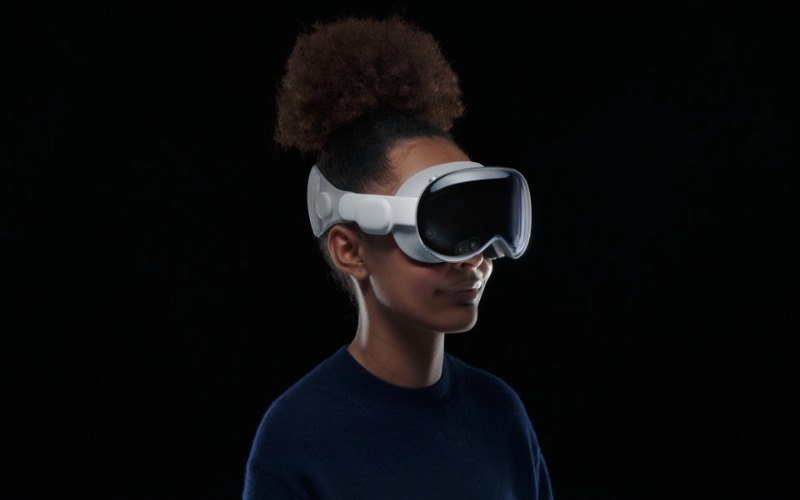After the release of Apple’s Vision Pro on Feb. 2, its popularity rapidly spread nationwide. With its ability to bring digital content to physical surroundings, every tech enthusiast seemed to want to get their hands on it and try it out for themselves. With its 23 million pixels, 3D display system, and video mirroring, it takes tech’s potential to another level with support for vision, hearing, mobility, learning, and more.
In light of its rapid adoption in the industry, we’ve dived deep into various reviews and trial phases to gather a pros and cons list for our readers. Here is what we’ve found!
The Good
Superb Media Player
The Apple Vision Pro’s spatial computing makes entertainment exciting and addicting. According to Apple’s website, the new device includes Apple TV, which makes it easy for anyone to watch their favorite sports games, 3D movies, television series, and more. All previously purchased media content is transferred to the Vision Pro if you sign in with the same Apple ID.
ZDNET’s review of the Vision Pro exemplifies its ability to make media even more immersive and enjoyable: “My biggest surprise in using the Vision Pro for several weeks was how often I found myself reaching for it to use as a media player. Being able to have the equivalent of roughly a 100-inch to 150-inch screen with incredible picture quality and crisp surround sound in any room or any location is addicting. And then when you add in the ability to watch movies in a true 3D experience, it takes things to another level.”
Unique Camera Abilities
This spatial computing device has special camera abilities like never before. With a stereoscopic 3D main camera system, the Vision Pro captures photos and videos with 18 mm, ƒ/2.00 aperture, and 6.5 stereo megapixels.
FStoppers noted the Vision Pro’s camera abilities and how it’s a winner for those wanting to take unique snapshots of their days: “First, how about taking photos and video? Uniquely, the AVP can take spatial videos, basically 3D videos. They can be played back on the Vision Pro, and they look pretty good. You can also take spatial stills (3D photos) on the Vision Pro. The stereoscopic cameras operate at f/2 and are 18mm, so pretty wide. I found pictures taken in fairly low light rendered nicely, but if it gets too dark, noise takes over. The cameras each produce a 6.5-megapixel image, not exactly high quality in terms of detail, but not terrible, especially in a 3D video or still because the 3D effect can sort of makeup for the lower resolution.”
Virtual Avatars
The unique digital avatars created by the Vision Pro may seem too futuristic, but it’s here and real. Once purchasing this new tech device, it will use the neural network to scan your facial features and create a hyperrealistic avatar. This avatar will replace your face during Zoom meetings, FaceTime, and more.
EndGadget comments on how these virtual avatars can be convenient and how they’ve improved: “A key feature of Apple’s Vision Pro VR, er, spatial computing headset is Personas that that lets people see a digital version of themselves during calls, Zoom meetings, etc. At launch, they looked a bit creepy, but Apple has improved them considerably in the latest release. They’re now more realistic, so users look less like impressionist paintings and more like humans.”
The Bad
High Price
Many reviewers have noted the high price tag on the Apple Vision Pro, and we can attest to that. Today, the device will cost you $3,499. According to statistics pulled from Statista, this number is extremely higher than other headset competitors, such as the Pico 5 Pro Max, Meta Quest Pro, and PlayStation VR2.
Tom’s Guide explained its concerns with the price and the possibility for more affordable options in the future: “The super expensive price is a big one, as it will greatly limit this headset’s initial appeal. Some may want to wait for the rumored lower-cost version on the horizon, but there’s no timetable for that. I also found the tethered battery to be annoying at times and the Personas while admirable are a bit unnerving to look at. So hopefully they look considerably better after the beta stage.”
Troubles With Apps
The Vision Pro should be able to give users countless opportunities to interact with apps using spatial computing. According to reports by AppFigures, 52% of Vision Pro-only apps are paid downloads. Additionally, 35% of Vision-only apps didn’t monetize through the App Store and 13% offered subscriptions.
After trying out the Vision Pro, CNET believes Apple didn’t quite hit the mark with its apps: “There are plenty of missed opportunities. Maps, Apple’s app, which already has rich 3D detail, isn’t VisionOS optimized. Pages still have the same interface as the iPad version. GarageBand (which could have had virtual instruments) isn’t optimized, and neither is iMovie. Apple will certainly adapt these over time, but not yet.”
The Ugly
Uncomfortable and Unattractive Design
Issues such as redness and dry eyes have been an issue for headset users over the years, but these complaints seem to be much more prevalent with the Vision Pro. Customers have been returning the new device simply due to the pain it causes. For example, there have been reports of headaches, intense eyestrain, and general discomfort. Motion sickness has also been a leading issue for users.
In addition to the headset being uncomfortable, reviewers note the awkward design of the Vision Pro. ComputerWorld reports that the biggest problem you’ll have to overcome is the look of it: “People don’t particularly like wearing hardware such as eyeglasses or helmets. Sure, they’ll wear dark glasses, but often because they think they look more attractive with them under certain conditions. This suggests that unlike most of the virtual reality and augmented reality solutions already on the market, Apple knew it needed to make its headset attractive. While it is better than most, the Vision Pro still makes whoever is wearing it look kind of dorky.”











